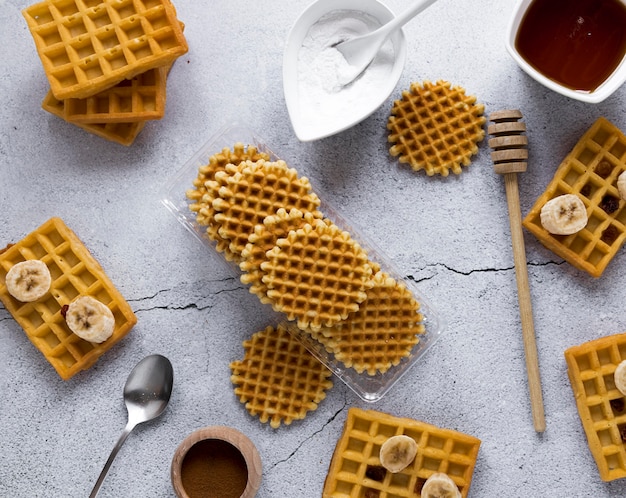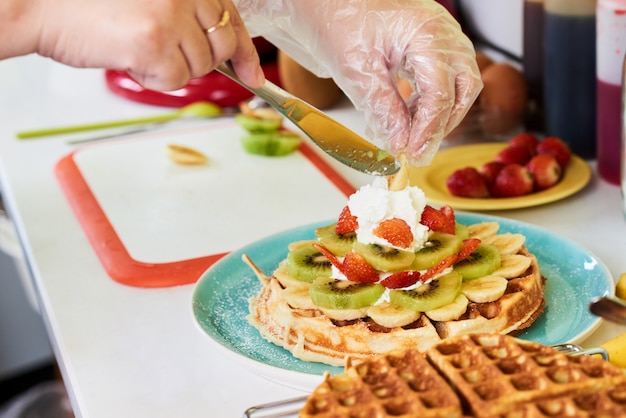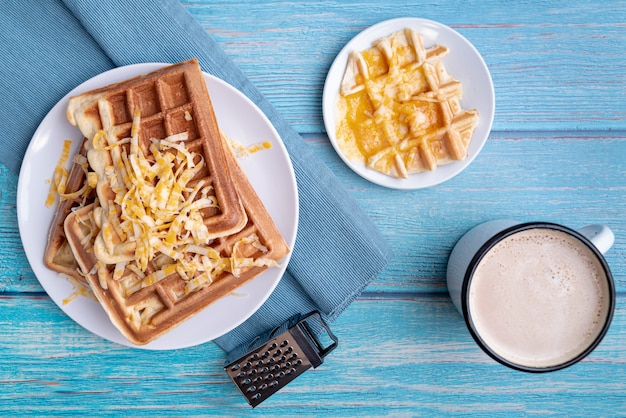Let’s talk waffles. Who doesn’t adore a golden, crispy, perfectly-cooked waffle? Whether you’re a weekend brunch aficionado or a weekday breakfast newbie, mastering the art of waffle-making is a must. But the biggest hurdle? Getting that perfect cooking time down. It’s easy to end up with a soggy mess or a burnt offering if you don’t know your waffle maker’s quirks. So, grab a cuppa, settle in, and let’s delve into the ultimate guide to waffle maker cooking times.
(Part 1) Understanding Your Waffle Maker

Before we jump into specific timings, we need to get to know your trusty waffle maker. Every machine is unique, and that makes a big difference when it comes to cooking times.
1.1. The Power of Your Waffle Maker
First things first, check the wattage of your waffle maker. Higher wattage generally means faster cooking times. My old, trusty one, a real workhorse, is only 700 watts. It takes its sweet time to cook a waffle, but that’s just its personality. A newer one, with a higher wattage, would whizz through a batch in half the time!
For example, if you’re using a 700-watt waffle maker, a classic waffle might take around 5 minutes to cook, while a 1200-watt model might only need 3 minutes. It’s all about adjusting your timings based on the power of your machine.
1.2. Non-Stick Coating Matters
A good non-stick coating is your best friend, ensuring your waffles release easily and prevent sticking. But, even the best non-stick coating can wear down over time. If your waffle maker is getting a bit long in the tooth, you might find your waffles need a little longer to cook through. That’s when you might need to add an extra minute or two to the recommended time.
If you notice your waffles are starting to stick, try applying a thin layer of butter or oil to the plates before pouring in your batter. This can help prevent sticking and ensure your waffles release beautifully.
1.3. The Importance of Even Heating
A crucial factor in getting even browning and cooked-through waffles is even heating. Check your waffle maker. If the heating elements seem to be unevenly distributed, you might notice some parts of your waffles cook faster than others. You’ll need to adjust your timings accordingly, maybe even rotating your waffle halfway through to ensure even browning.
If you notice your waffle maker has uneven heating, it might be time to consider a new one. A waffle maker with a consistent heating element will result in more evenly cooked waffles, reducing the need for constant adjustments and ensuring a more enjoyable waffle-making experience.
(Part 2) The Basic Waffle Batter Rules

Right, let’s move on to the batter. The type of batter you’re using has a big impact on cooking times.
2.1. The Density of Your Batter
Thicker batters, like those with a high proportion of flour, take longer to cook through. Thinner batters, on the other hand, cook faster. Remember, I’ve been making waffles for years, and I’ve learned that a good, well-balanced batter is key. You want something that’s thick enough to hold its shape, but not so thick that it takes forever to cook.
To achieve that perfect consistency, make sure you follow your recipe carefully and use good quality ingredients. You can also try using a whisk or a blender to incorporate air into your batter, which will help create a lighter and fluffier texture.
2.2. The Magic of Ingredients
Certain ingredients can affect cooking times. For example, waffles with lots of fruit or chocolate chips will take longer to cook, as these ingredients tend to hold onto moisture. You’ll also need to adjust your timings for batters with lots of nuts or other additions.
If you’re using a batter with lots of additions, consider spreading them evenly throughout the waffle maker to ensure even cooking. You can also try adding a little extra baking powder to help the batter rise and cook through more quickly.
(Part 3) The Ultimate Guide to Waffle Maker Cooking Times

Now we’re getting to the juicy part. The timings! This is where I’ll share all my tried-and-true tips for perfecting the art of waffle-making. Remember, these are just starting points, and you might need to tweak them depending on your waffle maker and your batter.
3.1. The Classic Waffle: A Starting Point
For a standard waffle batter, made with flour, eggs, milk, and baking powder, you’ll want to start with a cooking time of around 3-5 minutes. Start by checking your waffles after 3 minutes. They should be golden brown and cooked through. If not, give them another minute or two.
Here’s a little tip: When you press the waffle maker down, the steam coming out should be consistent and not overly vigorous. If there’s lots of steam, it means the waffle is not cooked through yet. If there’s no steam, it means it’s cooked through and might be starting to get dry.
3.2. Belgian Waffle Time
Ah, Belgian waffles! Those beautiful, deep-pocketed beauties. These take a little longer to cook through. Think about it, they have all those nooks and crannies to fill with deliciousness. So, start with 4-6 minutes. Check them after 4 minutes, and then add another minute or two if needed. You’ll know they’re done when the steam coming out is less vigorous and the waffles are beautifully golden brown.
If you’re making Belgian waffles, you might need to use a slightly thicker batter to ensure the waffles maintain their structure and don’t become too thin. This will help ensure that the batter cooks through evenly and doesn’t result in a soggy waffle.
3.3. The Case of the Thin Waffle
Those wafer-thin waffles, often used for ice cream cones or dessert waffles, cook much faster. You’re talking about a couple of minutes. Don’t be afraid to check them after only 1 minute! You want them golden brown and crisp. They’re delicate, so be careful when you’re flipping them out of the waffle maker.
If you’re making thin waffles, make sure you don’t overcook them. The goal is to achieve a crispy texture without burning them. If you notice the edges starting to brown too quickly, you can try lowering the heat on your waffle maker.
(Part 4) How to Know When Your Waffles are Done
Right, now that we’ve established some basic timings, let’s talk about how to know if your waffles are perfectly cooked. There are some key signs you’ll need to look out for.
4.1. The Golden Brown Test
A beautiful, golden-brown color is the first sign that your waffle is ready. It should be evenly browned all over, with no pale patches.
4.2. The Steam Check
As I mentioned before, the steam coming out of your waffle maker can be a great indicator. When the steam is consistent, not overly vigorous, and the waffle is a lovely golden brown, you know it’s ready. If there’s no steam, it might be starting to get dry.
4.3. The Touch Test
Yes, you can touch it! Gently touch the waffle with your finger. If it feels firm and not doughy, it’s likely cooked through. If you find it’s still a bit soft, give it another minute or two.
4.4. The Toothpick Test
If you’re still unsure, you can always do the toothpick test. Insert a toothpick into the centre of the waffle. If it comes out clean, your waffle is done. If there’s batter clinging to it, it needs more time.
(Part 5) Tweaking the Timings
Remember, these timings are just starting points. You’ll need to adjust them depending on your waffle maker and your batter. Now, let’s talk about some common factors that might require you to adjust your timings.
5.1. The Batter Factor
As we discussed earlier, thicker batters need more time to cook through. You might need to add an extra minute or two to the recommended cooking time. Thin batters, on the other hand, will cook faster.
If you’re using a thicker batter, you might want to reduce the amount of batter you pour into the waffle maker. This will help ensure the batter cooks through evenly and doesn’t overflow.
5.2. The Ingredient Factor
Ingredients like fruit, chocolate chips, or nuts can also affect cooking times. If your batter is loaded with these goodies, you’ll need to add a bit more time to ensure everything cooks through properly.
If you’re using a batter with a lot of additions, consider preheating your waffle maker for a few minutes before adding the batter. This will ensure the plates are hot enough to cook the batter quickly and evenly.
5.3. The Waffle Maker Factor
Your trusty waffle maker has its own personality. A newer model with a higher wattage will cook waffles faster than an older one. And, as I mentioned, a waffle maker with an unevenly distributed heating element might require you to rotate your waffles halfway through cooking to ensure even browning.
If you notice your waffles are cooking unevenly, try rotating them halfway through the cooking process. This will help ensure that both sides of the waffle receive an equal amount of heat and result in a perfectly golden-brown waffle.
(Part 6) Troubleshooting Common Waffle Problems
Right, let’s face it. Sometimes, things go wrong in the kitchen. Even the best waffle-maker can produce a few duds now and then. Here’s a quick guide to common waffle problems and how to troubleshoot them.
6.1. Soggy Waffles: The Bane of Every Waffle Maker
Soggy waffles are the bane of every waffle-maker’s existence. The most common culprit is a batter that’s too thin. Make sure your batter is thick enough to hold its shape. Another reason could be undercooked waffles. Give them a little longer in the waffle maker, and they should firm up nicely.
If you’re having trouble with soggy waffles, try using a thicker batter or adding a little more flour to your existing batter. This will help the waffles cook through more quickly and prevent them from becoming soggy.
6.2. The Burnt Offering: Too Much Heat
Burnt waffles are another common problem. It usually means you’ve left them in the waffle maker for too long. The solution? Watch your waffles like a hawk! Check them frequently, and if they’re starting to get too brown, pull them out immediately.
If you’re prone to burning your waffles, consider lowering the temperature on your waffle maker or reducing the cooking time. This will help ensure that your waffles cook through evenly without becoming burnt.
6.3. Stuck Waffles: The Nightmare Scenario
Oh, the horror! A stuck waffle. It can be a real nightmare. It’s usually a sign of a waffle maker that needs a good cleaning. Give your waffle maker a scrub with warm, soapy water. If the problem persists, try greasing the plates with a little oil or butter.
If you’re still having trouble with stuck waffles, try using a non-stick cooking spray or a thin layer of butter or oil to grease the plates before pouring in your batter. This can help prevent sticking and ensure your waffles release beautifully.
(Part 7) Mastering the Art of Waffle Making
Right, let’s sum up everything we’ve learned. To become a true waffle master, you need to understand the basics, be adaptable, and embrace the learning process.
7.1. Know Your Waffle Maker
You’ve got to know your trusty waffle maker like the back of your hand. Understand its power, its heating capabilities, and its quirks.
7.2. The Batter is King
Master the art of making a good, well-balanced batter. Remember, thicker batters need more time, and thin batters cook faster.
7.3. Watch, Smell, and Feel
Use your senses! Look for that golden-brown colour, sniff for the sweet aroma of freshly cooked waffles, and gently touch the waffle to check if it’s firm.
7.4. Embrace the Learning Process
It takes practice! Don’t be afraid to experiment. You’ll learn your waffle maker’s quirks and perfect your timing with every batch.
(Part 8) A Waffle-Making Journey
Right, so there you have it! My waffle-making journey has been filled with burnt offerings, soggy messes, and a whole lot of delicious discoveries. Now, with this guide in hand, you’re ready to embark on your own journey to waffle perfection.
Remember, making waffles is a journey, not a race. Have fun, be patient, and above all, enjoy the process.
FAQs
1. What temperature should I set my waffle maker to?
Most waffle makers have a temperature dial or buttons for different settings. For most standard and Belgian waffles, you want to cook them at a medium to high setting. However, you might need to adjust the temperature depending on your batter and waffle maker. If you find your waffles are getting burnt too quickly, try lowering the temperature.
The best way to determine the ideal temperature is to experiment and find what works best for your waffle maker and batter. You might find that a medium setting is ideal for classic waffles, while a higher setting is better for Belgian waffles.
2. Should I grease my waffle maker?
Whether you grease your waffle maker or not depends on the non-stick coating and your preferences. If your waffle maker has a good non-stick coating, you probably won’t need to grease it. However, if your waffle maker is getting a bit old, or if you want extra insurance against sticking, a light greasing with butter or oil can be helpful.
If you decide to grease your waffle maker, use a light layer of butter or oil. Too much grease can make the waffles soggy or greasy. You can also use a non-stick cooking spray, which is often easier to apply evenly.
3. How long should I keep my waffle maker plugged in?
It’s best to leave your waffle maker plugged in throughout the cooking process. This ensures that the plates maintain a consistent temperature, which is crucial for even cooking.
If you’re only making a small batch of waffles, you can unplug the waffle maker once the waffles are cooked. However, if you’re making multiple batches, it’s best to keep it plugged in to ensure that the plates stay hot and ready for the next batch.
4. What do I do if my waffles are sticking?
If your waffles are sticking to the waffle maker, it might be time for a good cleaning. Use warm, soapy water to scrub the plates thoroughly. If the problem persists, try greasing the plates with a little oil or butter before making your next batch.
If you find that your waffles are still sticking after cleaning the waffle maker, it might be a sign that the non-stick coating is wearing down. You might need to consider replacing your waffle maker with a newer model that has a better non-stick coating.
5. Can I freeze leftover waffles?
Absolutely! Leftover waffles freeze beautifully. Place them in a freezer-safe bag or container, and they will stay fresh for several months. To reheat them, simply toast them in a toaster or oven.
To reheat frozen waffles, you can also place them in a toaster oven or on a baking sheet in a preheated oven. This will help ensure that they are heated through evenly and become crispy again.
Everyone is watching

How to Cook Frozen Lobster Tails Perfectly: A Step-by-Step Guide
RecipesLobster. Just the word conjures up images of lavish meals, special occasions, and a taste of luxury. But let's...

Pigs in a Blanket Cooking Time: How Long to Bake for Perfect Results
RecipesAh, pigs in a blanket. Just the name conjures up images of those delightful little parcels of crispy pastry en...

Pork Fillet Cooking Time: How Long to Cook It Perfectly
RecipesPork fillet, or tenderloin as it's sometimes called, is a real favourite in our house. It's so versatile, and...

The Ultimate Guide to Cooking Delicious Frankfurters
RecipesLet's face it, we all love a good frankfurter. It's a classic, simple, and always satisfying. But let's be rea...

Wolf Meat Recipes: A Guide to Cooking Wild Game
RecipesLet's be honest, you don't see wolf meat at your local butcher shop every day. It's a bit of a wild card, but ...
